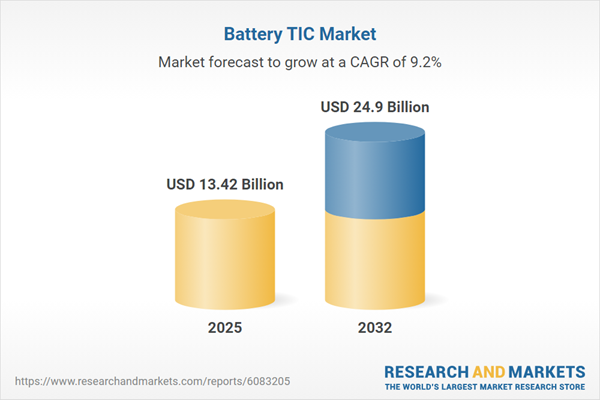Speak directly to the analyst to clarify any post sales queries you may have.
The Battery TIC Market is evolving rapidly as global industries intensify their focus on battery safety, regulatory compliance, and performance standards. This creates new demands and opportunities for testing, inspection, and certification (TIC) solutions that meet the complex needs of battery-dependent sectors worldwide.
Market Snapshot: Battery TIC Market Growth and Sector Outlook
The Battery TIC Market grew from USD 12.34 billion in 2024 to USD 13.42 billion in 2025. It is expected to continue growing at a CAGR of 9.17%, reaching USD 24.90 billion by 2032. This market trajectory underscores robust adoption across automotive, aerospace, energy storage, healthcare, and industrial segments. Strategic investment in state-of-the-art testing facilities, digitalization, and quality assurance underpins sustained momentum. Market players are responding to both the scale and complexity of evolving compliance needs, an evolution shaped by new chemistries, end-use applications, and global regulatory frameworks.
Scope & Segmentation
- Battery Types: Lead-acid batteries, lithium-ion batteries, nickel-cadmium batteries, and nickel-metal hydride batteries, each demanding differing TIC services according to performance and safety requirements.
- Service Types: Certification of regulatory compliance, inspection services to assure quality at manufacturing milestones, and a range of comprehensive tests including capacity, endurance, environmental, performance, and advanced safety assessments.
- Testing Stages: Evaluation during development, in-production quality control, and post-manufacture validation ensure integrity throughout the product life cycle.
- Source of Service: In-house testing operations for proprietary technologies are balanced against outsourced, third-party laboratory evaluations offering independent verification.
- End-Use Industry Focus: Aerospace and defense, automotive, energy storage systems, healthcare, industrial, and telecommunications sectors drive market demand with tailored technical and regulatory criteria.
- Regional Coverage: North America, Latin America, Europe, Middle East, Africa, and Asia-Pacific, each presenting unique growth drivers and compliance requirements fostered by local industry and regulatory dynamics.
- Key Technology Integration: Adoption of digital twins, high-throughput automated platforms, real-time simulation, and AI-driven analytics enhance reliability, speed, and scalability of TIC solutions.
Key Takeaways: Strategic Insights for Battery TIC Stakeholders
- Battery TIC market expansion reflects increased electrification and the growing role of renewable energy sources.
- Rigorous, harmonized international safety and environmental standards are accelerating the adoption of advanced TIC protocols.
- Service providers are leveraging digital analytics, simulation, and real-time monitoring to minimize time-to-market for both established and emerging battery chemistries.
- Regional differentiation in service offerings is emerging, with Asia-Pacific focusing on efficient, large-scale testing, and Europe emphasizing high-precision environmental and safety validation.
- Sustainability trends are spurring new TIC requirements for second-life and recycled batteries, integrating circular economy guidelines into standard procedures.
- Strategic partnerships, such as collaborations with equipment manufacturers and academic research institutions, are key to driving certification innovations and market responsiveness.
Tariff Impact: Navigating Shifting Trade and Supply Realities
Recent United States tariff adjustments have reshaped sourcing strategies, increased equipment costs for laboratories, and contributed to lead time volatility. Many TIC providers now prioritize partnerships with domestic manufacturers and localized lab investments to mitigate disruptions. Enhanced customs compliance and risk assessment protocols are becoming essential in operational planning and certification roadmaps.
Methodology & Data Sources
This research employs a mixed-method approach, integrating in-depth interviews, structured surveys, and secondary analyses from regulatory and technical sources. Data triangulation ensures balanced, accurate findings. Peer reviews and domain expert validation underpin research integrity, ensuring stakeholders gain actionable, rigorous insights.
Why This Report Matters
- Facilitates strategic decision-making by mapping regulatory, technical, and trade developments impacting the Battery TIC Market.
- Assists stakeholders in identifying investment priorities, regional opportunities, and emerging sustainability-driven service areas.
- Enables benchmarking against industry best practices for technology adoption, risk management, and certification innovation.
Conclusion
As battery-dependent industries accelerate, the pace of TIC market evolution brings both greater complexity and opportunity. This report equips senior leaders with the clarity and foresight needed to navigate ongoing changes and sustain a competitive, compliant position in global markets.
Table of Contents
3. Executive Summary
4. Market Overview
7. Cumulative Impact of Artificial Intelligence 2025
Companies Mentioned
The companies profiled in this Battery TIC market report include:- AGC Inc.
- ALS Limited
- Applus Services SA
- BSI Group
- Bureau Veritas S.A.
- Cotecna Inspection SA
- DNV GL
- Emerson Electric Co.
- Eurofins Scientific SE
- Hohenstein Laboratories GmbH & Co. KG
- Intertek Group plc
- Kiwa NV
- Lloyd's Register Group Limited
- Mistras Group, Inc.
- Omnex, Inc.
- Pony Testing International Group
- RINA S.p.A.
- SGS SA
- SIRIM BERHAD
- SOCOTEC Group
- TIC Group by Pact Group Holdings Ltd
- TV Nord Group
- TÜV SÜD AG
- UL LLC
Table Information
| Report Attribute | Details |
|---|---|
| No. of Pages | 187 |
| Published | November 2025 |
| Forecast Period | 2025 - 2032 |
| Estimated Market Value ( USD | $ 13.42 Billion |
| Forecasted Market Value ( USD | $ 24.9 Billion |
| Compound Annual Growth Rate | 9.1% |
| Regions Covered | Global |
| No. of Companies Mentioned | 25 |









